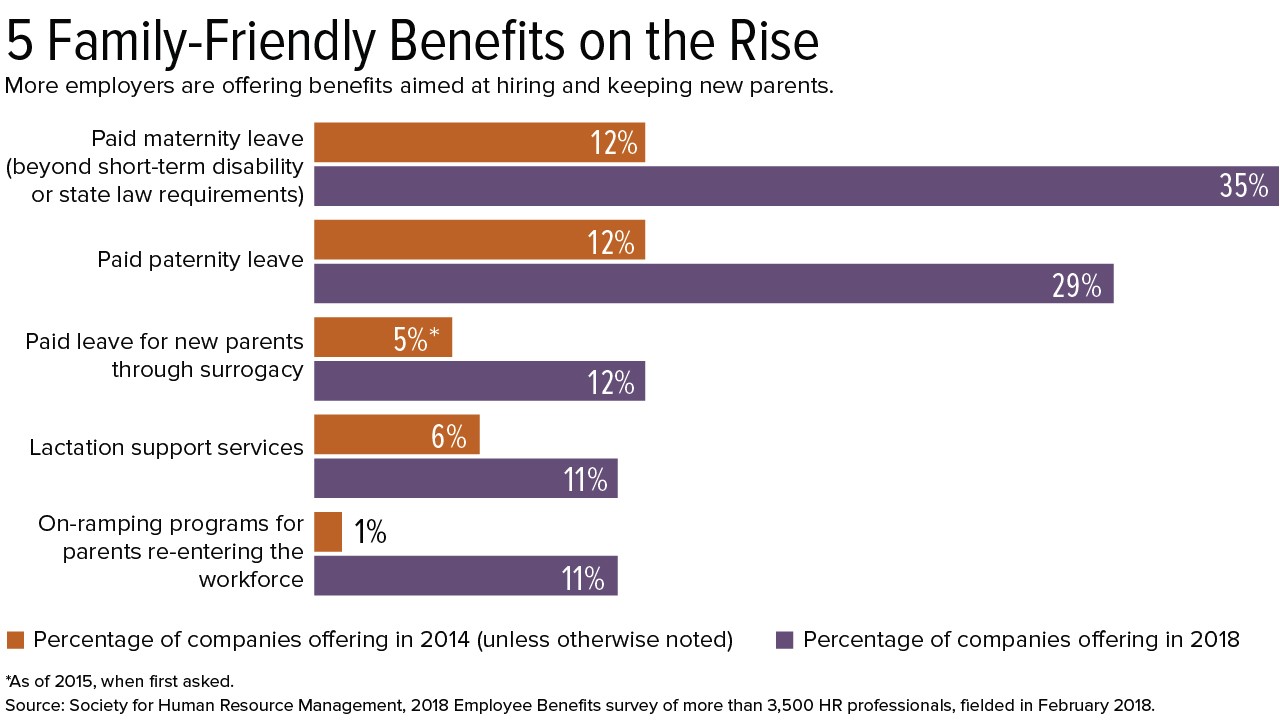Support for New Parents Can Keep Employees On Board
More paid leave and new perks help employees meet family needs

Having a child is one of life's greatest transitions, even if you've done it before. Returning to work afterward can be a crossroad in an employee's career and life. If employers don't provide enough support during this time, they could lose some of their best talent to an organization that does.
As an example of what is at stake, 23 percent of employees have considered quitting a job due to child care issues, with women three times more likely than men to consider doing so. Those figures come from a January 2019 survey of 518 workers by Workplace Options, an employee services provider.
As more people delay having children, their childbearing and child-rearing years increasingly overlap with their prime working years. This has implications for employers seeking to attract and retain the talent they need. With 7.3 million job openings in an economy with only 6.54 million unemployed workers, according to the U.S. Bureau of Labor Statistics, employers seeking employees with specific skills and experience are likely to have an even greater challenge replacing those who leave.
Turnover in general is costly. Turnover among an organization's most important contributors is even more so.
Easing the Transition
Considering this, it's no surprise that employers are enhancing their programs to support parents. "An increase in paid time off is the way the market is going," said Barbara Brickmeier, vice president of benefits and wellness at IBM. Beyond that, "We constantly tweak our program to make sure we are meeting those needs."
Professional services firm PwC has focused its enhanced family benefits on the transition from paid parental leave to return to work. Employees could already pull together 20 weeks of paid leave using a combination of eight weeks of paid parental leave, vacation days and short-term disability for mothers giving birth. However, the transition from being 100 percent off work to 100 percent back to work was proving a difficult adjustment for many new parents.
To help ease this transition, the firm added four weeks of return-to-work time during which employees can work a 60 percent reduced schedule for full pay. Since it went into effect in July 2018, 300 employees, 60 percent of whom are mothers, have taken advantage of this benefit, said Jenn Allyn, PwC's diversity strategy leader based in New York.
Other employers are trying this approach. This year, Noodles & Company, which serves up fast, casual pasta dishes, started allowing management-level expectant mothers to phase out of work before the baby's birth and then to phase back in after delivery, while receiving full salary. Eligible new mothers, in addition to receiving six weeks of paid maternity leave, can work an 80 percent schedule during the four weeks before and the four weeks after maternity leave while receiving full pay. Eligible fathers and foster or adoptive parents receive two weeks of paternity/bonding leave after their child arrives.
(Click on graphic to view in a separate window.)
Stepping In to Help Out
Smaller employers can also provide support to new parents. Start-up technology firm Phone2Action in Washington, D.C., uses temporary employees and other support to fill in for new parents, who can take up to six weeks of paid parental leave.
"Other employees also step up to take on responsibilities and cover important assignments," said Jeb Ory, the firm's CEO. "We think sharing the responsibility is the right way to do it because it creates a base of trust and genuine happiness for our colleagues as they take on the new role and challenge of being a parent." The employees stepping in to help can also gain important experience that will benefit the firm and help them in their own careers.
[SHRM members-only how-to guide: How to Develop and Administer Paid Leave Programs]
Giving It a Try
Smaller firms can also build their parental benefits programs over time. Ory's firm started by offering six weeks of leave for new parents and eventually expanded that to 12 weeks.
Although IBM has considerably more resources for parental benefits, it takes a similar approach to these programs by trying new ideas and expanding its programs over time. For example, when the company was considering breast milk delivery for nursing mothers who travel for work, there was some question about whether it was necessary. "This would help a small population of a couple of hundred employees, so why not try it?" Brickmeier said. "It will help these employees get back to their careers more easily, so it's a win-win."
Same Benefits, Different Circumstances
Employers offering parental benefits should be aware of changing employee needs. For example, as reproductive technology has expanded and improved, employees using a surrogate to have a child need just as much support as other new parents. That is why companies are starting to offer parental benefits to all employees who become parents. That means providing paid time off for child-bonding to spouses and partners, parents who have a child through a surrogate, and parents who adopt a child.
"We don't differentiate by the relationship to the child," Brickmeier said. "An employee who has a child with a partner is treated the same as someone who has a child with a spouse. Not every company does that."
Apparel Firm Announces 8 Weeks Paid Parental Leave VF Corporation, owner of The North Face, Vans and Timberland clothing brands and retail outlets, announced it will offer eight weeks of paid parental leave for all benefits-eligible U.S. employees beginning May 1. The new benefit, which will apply to maternal, paternal and adoptive parents, is in addition to company paid and state specific short-term disability coverage for birth mothers. VF's full-time salaried and hourly employees who work a minimum of 30 hours per week—including in its retail stores and distribution centers—will be eligible for the benefit after one year of continuous service. For adoptive parents, the eight weeks of paid leave complements the company's adoption assistance benefit, which reimburses eligible adoption-related fees and expenses. "Our new paid parental leave program will give new parents the time they need away from work so they can focus on their family after the birth or adoption of a child," said Anita Graham, VF's chief HR officer. The firm regularly reviews its benefits and seeks employees' input to ensure it's providing competitive offerings that support employees and their families, she said. |
Joanne Sammer is a New Jersey-based business and financial writer.
Visit SHRM's resource page for Paid Time Off
Related SHRM Articles:
What Companies Need to Know to Retain New Moms, SHRM Online, February 2019
How Much Parental Leave Is Too Much?, SHRM Online, February 2019
To Improve Gender Equality, Help Men Take Parental Leave, SHRM Online, January 2019
Phased Parental Leave Enhances Family Benefits, SHRM Online, September 2018
Companies Add New Twists to Parental Leave, SHRM Online, November 2017
An organization run by AI is not a futuristic concept. Such technology is already a part of many workplaces and will continue to shape the labor market and HR. Here's how employers and employees can successfully manage generative AI and other AI-powered systems.




